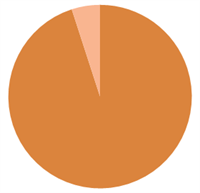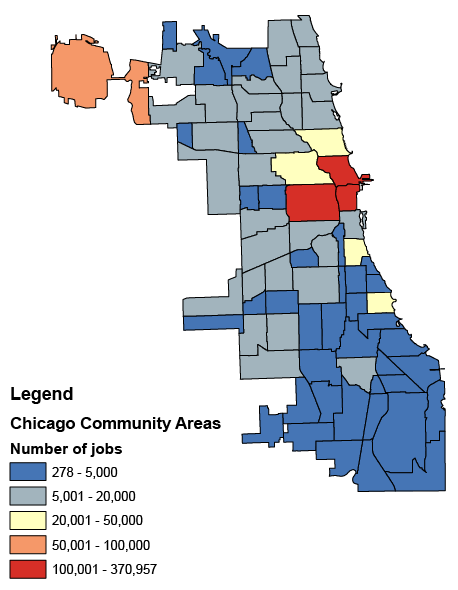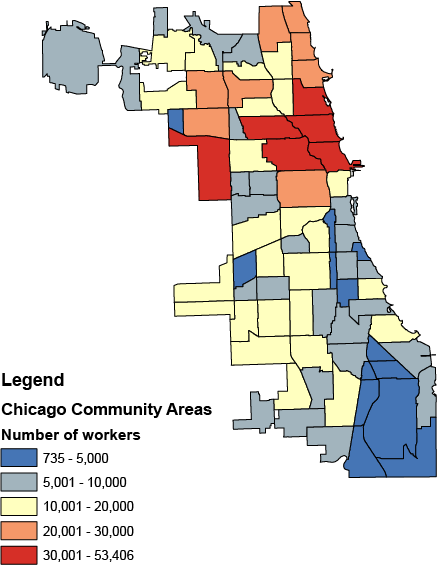This is the second of five posts in our "jobs-housing puzzle" series. Every day thousands of people commute to and from each of Chicago’s neighborhoods and suburbs, but only a small minority spends the work day in the same community that it wakes up in. Overwhelmingly people do not live and work in the same place. In this blog series, we’ll cover current statistics on where people are and where they’re going, and what that means for the communities in which they live and work. You can find all the posts in the series here.

Of the 989,874 workers living in the city of Chicago, only 5 percent work locally; the rest commute.
According to the U.S. Census OnTheMap tool, which assembles data on employment locations throughout the country, there were 989,874 workers living in the city of Chicago in 2011, not including uniformed military personnel, the self-employed or those in the informal economy (in all we estimate there are approximately 250,000 workers not included). An MPC analysis shows that only 50,474 of these almost 1 million employees work in the same community area as they live (about 5 percent). More than one third did not work within the city.
As we might expect, jobs are often concentrated in different areas than residences. The Loop had the most jobs of any part of the city—370,957, almost one third of the city’s total (1,175,294). However, only 14,956 workers live in the Loop. In contrast, West Englewood is home to 10,361 people who work, but has only 1,428 jobs.

There is often an imbalance in the number of workers and jobs in a neighborhood.
Yet even in employment centers, there is a disconnect between residences and jobs. Of the 15,000 people living in the Loop, only 36 percent work there. Every day, hundreds of thousands of people commute into the Loop, but the majority of those who live there are commuting out! Equally surprising, West Englewood’s 1,428 jobs are almost entirely filled by people who live outside the community; just 69 are filled by workers who live in the boundaries of West Englewood. This same pattern can be seen across the city. Only five of Chicago’s 77 community areas employ more than 10 percent of their workers, and only seven had more than 10 percent of their jobs filled by local residents.
Even when we examine commute patterns at the scale of larger planning districts (Chicago is divided into seven planning districts), we find that most people are living and working in different places. More than 80 percent of jobs on the South Side are filled by people living in other parts of the city (or outside the city), and only 13 percent of people who live on the North Side work there.
The distribution of jobs means that some workers will have to commute as most community areas have more workers than positions to be filled. In theory, if all jobs were first filled by someone from the same community area, 535,181 workers could be employed in the same community as they live (54 percent). The actual figure is 50,474 (5 percent).
Suburbs as varied as Aurora, Evanston and Arlington Heights see 80 percent or more of their populations commute out of each municipality to work, despite having quite similar numbers of jobs and workers. Arlington Heights, for example, had 35,062 workers living in the village and 42,864 jobs located in the village but only 4,391 workers who both lived and worked there.
15,000 people live in the Loop; 36 percent work there...West Englewood has 1,428 jobs...just 69 are filled by workers who live in the boundaries of West Englewood.
There are many reasons that workers may not live close to their jobs. It could be that the options of where to live and work are limited or that jobs in an area are poorly matched to the skills of people living there. Other factors may also be much more important in locational decisions. People may choose to be close to family even if they cannot find a job in the area or they may choose a commute of 10 miles versus a commute of 3 miles if the job is more suitable and better paid.
Even if workers did try to locate close to jobs this would be more difficult for households with more than one person working. Of households with at least one worker in 2012 in Cook County, 43.9 percent had multiple earners and 8.5 percent had three or more earners.
The fact that the large majority of people are working somewhere very different from where they live undoubtedly is responsible for creating higher levels of traffic. And there may be some policies, such as employer-assisted housing, which MPC works on, that could increase the number of people who live and work in the same place. It seems likely, however, that from choice or necessity most people will continue to live and work in different places. This makes it important for us to consider the implications this has for planners, local government and community development.
Here are a few visual representations of the data described above:
Where residents work locally:

The percentage of residents who work locally is below 5 percent the majority of neighborhoods.
Where jobs are located:

It's easy to see where the job centers are in Chicago: The Loop and O'Hare.
Where workers live:

Much of the workforce in Chicago is on the north and northwest sides.